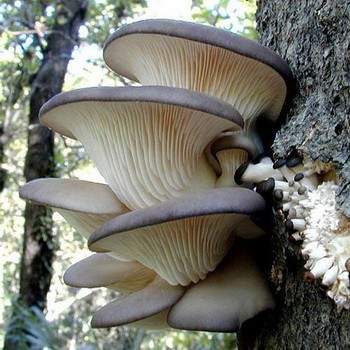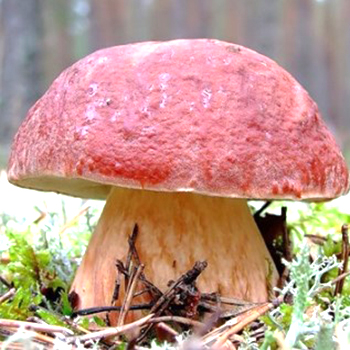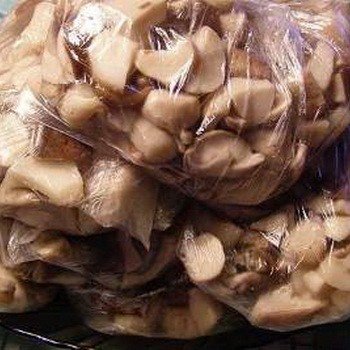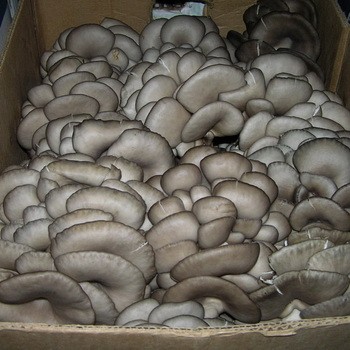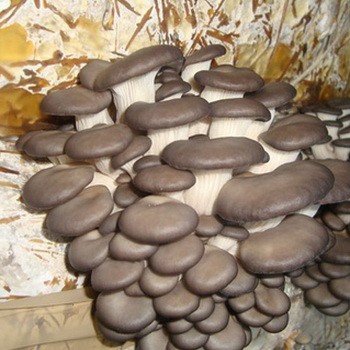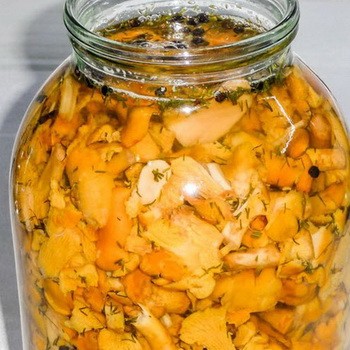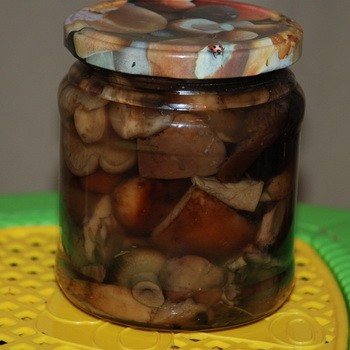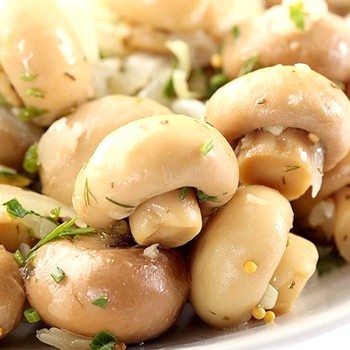Growing oyster mushrooms in different ways.
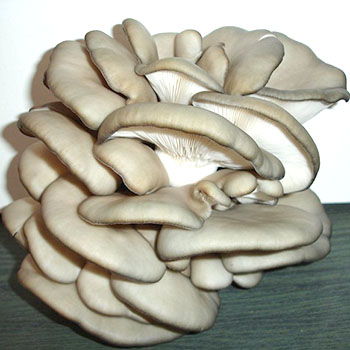
Beginners can grow oyster mushrooms in two ways: extensive (on stumps or trimmed wood) and intensive (in bags or other containers located in the room). Both technologies of oyster mushroom cultivation have been worked out to the smallest detail in the course of many years of experience, therefore cultivation of these fruit mushrooms is available even to inexperienced amateur mushroom growers.
Oyster mushroom ordinary, or oyster, is a fairly large mushroom with a dark hat, usually gray or brown in color with intermediate shades, which grows up to 200 mm in diameter. Over time, the hat becomes lighter. Oyster mushrooms are white or cream in color, gradually turning to a rather dense and stiff leg, which for this reason is not eaten.
About how to grow oyster mushrooms in bags and on stumps, you will learn by reading this material.
Content
Extensive and intense methods for growing oyster mushrooms
This mushroom is found exclusively on dead hardwood, and therefore is not dangerous for living trees in the garden. As a rule, large oyster mushroom sprouts are formed on the wood, each of which has up to 30 separate mushrooms, and the weight of the sprouts can be 2-3 kg.
Oyster mushroom grows in large quantities in natural conditions and in central Russia mushrooms can be harvested all summer and autumn, and the peak of fruiting intensity falls on August - October (specific dates are determined by air temperature).
The cultivation of oyster mushrooms is much different than the cultivation of champignons, while the taste in them is by no means worse. In addition, they are not lost as a result of drying or pickling.
Most often, planting material - sterile oyster mushroom mycelium - is acquired on the side for growing mushrooms. This should be done in spring or early fall, since it needs positive temperatures during transportation. Before planting the mycelium, it must be stored at a temperature of 0 to 2 ° C, then it will retain all its properties for 3-4 months, while at 18-20 ° C - only a week.
How to grow oyster mushrooms in the room or in the country? The methods of cultivation of these fungi can be divided into extensive and intensive.
Due to the fact that this mushroom is easily amenable to artificial cultivation on wood waste without any significant material costs, an extensive breeding method is very popular. Moreover, it is also quite well designed. We can say that the extensive method in its simplicity, reliability and low cost is most suitable for a summer cottage. Before growing the kit, newcomers are advised to watch the video and familiarize themselves with the literature; the process technology is described in detail.
The specificity of the intensive method of growing oyster mushrooms consists in the composition of the substrate used and the possibility of growing mushrooms indoors, for example, in a greenhouse or in an illuminated basement with adjustable conditions. A short ripening period (2-2.5 months) makes this method very attractive for growing oyster mushrooms in a subsidiary farm, in a garden and garden plot.
We developed this method in Hungary, but in Russia it was significantly improved. It was found that oyster oyster, like Florida (adapted for cultivation in an intensive way), grows excellently on plant materials like straw, sunflower husk, ears of corn, reeds, etc.
Under natural conditions, one cannot see oyster mushrooms growing on straw, sunflower husks, corncobs, etc., since mold fungi, which have a higher development rate and are capable of suppressing oyster mushrooms, have serious competition for it.
To get started, learn how to grow oyster mushrooms from the mycelium in an extensive way.
Extensive technology for growing oyster mushrooms on stumps in a summer house
Before you grow oyster mushrooms using extensive technology, you need to find the necessary pieces of wood of aspen, birch, poplar, etc. lengths within 300 mm and diameters from 150 mm and above. If they are thinner, then the yield will decrease. In order for the wood to be sufficiently moist, and this is necessary for the normal growth of the mycelium, the logs are kept in water for 1-2 days before use.
To grow oyster mushrooms in the country, stumps at the end of winter or the beginning of spring are moved to a cellar, basement or some similar enclosed space, placed one on top of another, forming columns up to 2 m high. First, the upper ends of the logs are covered with a layer of grain mycelium, the thickness of which is from 10-20 mm and more. Then another piece is installed on this piece of wood, the end of which is also treated with mycelium. Next, place the next segment, etc. Planting material is taken at the rate of 70-100 g per one end.
The columns are covered with straw from above for the sake of preserving moisture and creating conditions for better development of the mycelium, which eventually penetrates the wood. Instead of straw, some kind of fabric is often used, since polyethylene and other films are not suitable, because they do not allow air, which is necessary for growing mycelium.
To grow oyster mushrooms, certain conditions must be created: at a temperature of 10-15 ° С, oyster mushroom mycelium grows in wood for 2–2.5 months. The air in this room must be humidified, but do it carefully so that water does not get on the wood.
If champignon does not need light for normal growth, then oyster mushroom is necessary for fruiting. The second stage of cultivation of this fungus in central Russia falls on May. Pieces of wood with sprouted mycelium are taken out into the open air and deepened into the soil by 100-150 mm. From pieces of wood, rows are formed under the canopy of trees or in some other shaded places. To grow oyster mushrooms on stumps, you can create a shadow with a light artificial canopy.
The distance between the installed pieces of wood and between the rows should be 350-500 mm.
When growing on stumps, oyster mushrooms need proper care, which mainly consists in gentle watering of the soil in dry weather. Fruiting most often begins in August - September and lasts throughout October. Collect oyster mushroom, carefully cutting. The first harvest from one piece of wood gives over 600 g of first-class mushrooms, which are formed into large splices.
Additional information about growing oyster mushrooms on stumps is presented in this video:
Plantations overwinter where they were established in the summer. If the conditions are favorable, then in the second year from each piece of wood you can get 2-2.5 kg of mushrooms.The technology for growing oyster mushrooms on stumps allows you to get up to 20 kg of mushrooms per year from 1 m2 of wood, the most productive of which are the second and third years.
The following describes how to properly grow oyster mushrooms in a greenhouse.
How to grow oyster mushrooms in a greenhouse
As practice shows, oyster mushrooms can also be grown in greenhouses, where pieces of wood are placed in the ground in October - November, since it will not work to arrange them in columns.
At the same time, pieces of wood should be planted with grain mycelium. After drawing on the ends of the logs it is covered with wooden disks with a thickness of 20-30 mm of the same diameter as that of the log.
The advantage of growing oyster mushrooms in greenhouses is the ability to control key environmental parameters: humidity, air and soil temperature, which positively affects fruiting. The spread of mycelium over pieces of wood lasts 1-1.5 months (if the air temperature was 13-15 ° C, the soil 20-22 ° C, and the relative humidity 95-100%).
After the mycelium grows for two days, the temperature is sharply reduced to 0-2 ° C, which "spurs" fruiting. Then the temperature is increased to 10-14 ° C. After 2-2.5 months after planting the mycelium on wood, the onset of fruiting can be expected.
Breeding oyster mushrooms allows you to load the greenhouses with work in October - January, when they are usually empty. In the spring, when it becomes necessary to use greenhouses for vegetables, pieces of wood with mycelium are transferred to open ground.
Mushrooms can also be cultivated on stumps, for example, in a forest or in gardens where they are. A mushroom planted on them will destroy them biologically, which will allow them to harvest mushrooms for three years and get rid of unwanted stumps without resorting to uprooting.
Watch the video “We grow oyster mushrooms in a greenhouse”, which tells about all the nuances of cultivation:
Here is only an approximate general scheme of cultivation of the fungus. It can and should be amended in terms of planting (depending on the microclimate in the open air or indoors) and how to plant mycelium on pieces of wood.
In particular, it is possible to apply a somewhat more time-consuming, but giving good results method, which consists in first making holes in the end of the log section with a depth of 40-50 mm and a diameter of about 30 mm, where the grain mycelium is laid. Then they are covered with wet sawdust or pieces of bark, otherwise the mycelium will quickly dry out and will be defenseless against mold. If you act in this way, the planting material will grow faster on a piece of wood.
The following describes how to properly grow oyster mushrooms in bags in an intensive way.
How to properly grow oyster mushrooms in bags
There are sterile and non-sterile method of intensive cultivation of oyster mushrooms. The sterile method in the industrial cultivation of the fungus was tested first. Its essence is as follows: the substrate is moistened and placed in an autoclave, where it is sterilized, after which it is seeded with mycelium. Harmful microorganisms die, and oyster mushroom seed develops unhindered.
The results of the application of this method are quite good, but it is practically not used in the subsidiary farm, since it requires sterile conditions throughout the growing period or mixing in a sterilized substrate of a special microbiological additive, which includes a complex of bacteria that inhibit the growth of molds, and getting it is not so easy.
In the first half of the XX century. a non-sterile method of cultivating oyster mushrooms was invented, the essence of which is pasteurization (steaming) of a nutrient medium, while other processes proceed under non-sterile conditions.In this case, there is no need for any additives, however, the use of this method must be carried out with the strict observance of sanitary conditions, which will prevent the spread of mold and molds on the substrate.
This method is often used by single mushroom growers in small mushroom growing enterprises. However, it should be noted that industrial cultivation of the fungus in a non-sterile way consists of some complex technological methods, which requires special equipment and qualified specialists.
The non-sterile method, although effective enough, cannot fully guarantee a stable, high-quality crop, since there is always a danger of mold growth. Single mushroom growers can be recommended to breed this mushroom in small volumes, because in this case it is easier to perform
A nutrient medium for the cultivation of oyster mushrooms can be agricultural waste, for example, cereal straw, husk of sunflower seeds, corn, sawdust, shavings, etc. Only before use, you need to make sure that there is no mold on them, otherwise they will become a source of infection.
Agricultural waste can be mixed in various proportions, which leads to different results. All this allows mushroom growers not only to experiment, but also to make rational use of household waste.
The nutrient medium is crushed, 2% of ground limestone, 2% of gypsum, 0.5% of carbide, 0.5% of superphosphate (of the total weight) and water are added so that the final humidity reaches 75%. To accelerate the appearance of fruits and their increase, beer grains or bran are added to the mixture. Moreover, all additives should not exceed 10% of the total weight of the compost.
Then the nutrient medium is placed in containers for drying and kept there for 2-3 hours at a temperature of 80-90 ° C, periodically mixing. Thus, pasteurization of the substrate is carried out. Alternatively, you can treat the compost with hot steam at a temperature of 55-60 ° C for 12 hours.
If oyster mushroom is grown in sufficiently small volumes, the nutrient medium can be treated with boiling water in appropriate containers, after which they are covered and left for 2-4 hours. Then the water is drained, the substrate is dried to the required (70-75%) moisture and mineral substances are added.
The pasteurization of the nutrient medium can be performed as follows: fill the bags and install them in containers where steam or hot water is supplied, exposing the substrate to treatment for 6-10 hours.
In any case, heat treatment of the substrate is important to get rid of mold. It can be prepared in completely different ways, regardless of the method of cultivation of the fungus.
Upon completion of the heat treatment, the pasteurized nutrient medium must be gradually cooled, and then transferred to the place of planting. The substrate can be placed in plastic bags, boxes, etc., the sizes of which can be different. The best dimensions are 400x400x200 mm. The volume of the substrate should be large enough (5-15 kg) so that quick drying does not occur. It should also be pressed a little, while it is extremely important to ensure its cleanliness when placed in a tank for breeding mushrooms.
The mycelium is planted when the temperature of the substrate drops to 25-28 ° C. It is brought to a depth of 100-150 mm, evenly stirring with a nutrient medium. The volume of mycelium should be 5-7% of the mass of compost. If the planting material is less, then the substrate will grow longer, which only increases the risk of competing molds.
Mixing grain mycelium and pasteurized chilled substrate can be done before filling the tanks. In this case, due to the uniform mixing of the substrate with mycelium, the same uniform overgrowth of the nutrient medium occurs. This method of introducing mycelium requires utmost care to ensure cleanliness in workrooms.
To grow oyster mushrooms in bags as the correct technology suggests, you need to provide a temperature of 20-25 ° C and a relative humidity of 90% in the room. At this stage, the mushrooms do not need light. 3-5 days after planting, the surface of the nutrient medium is covered with a whitish layer of mycelium. Another 8-10 days will pass and, if the technology has been strictly observed, the culture medium will turn light brown, and then interweaving of white hyphae will appear, which indicates the beginning of maturation of the mycelium.
If the substrate with mycelium is in bags, then incisions are made on it to make way for growing mushrooms
In the process of mycelium development, it is necessary 1-2 times a day to determine the temperature in the depth of the nutrient medium. If it reaches 28 ° C or exceeds this figure, then the room must be carefully ventilated.
The process of mycelium development lasts about 20-30 days, and at the end of the substrate, penetrated by it, becomes a monolithic block. Then these blocks in bags or other containers are moved to a special room, called a growth room, where a stable temperature regime of 12-15 ° C is maintained and access of light is provided. Of course, if it is possible to reduce the temperature and light the room, you can leave the oyster mushroom where the substrate was overgrown with mycelium.
Oyster mushroom bears fruit better if the blocks are arranged vertically, after having removed them from the bags. Between the rows of delivered blocks, 900-1000 mm wide free space should be left in order to simplify crop care and harvesting. The location of the blocks depends on the characteristics of a particular room.
In principle, it is not necessary to remove the blocks from the bags, but in order for the mushrooms to grow on all sides, it is necessary to cut holes in the shell vertically and horizontally at a distance of 30–40 mm (or 100–150 mm) with a diameter of 10–20 mm. You can also make longitudinal or cross-shaped incisions. Sometimes blocks are strengthened, and some mushroom growers suspend elongated blocks in bags.
If the substrate with mycelium is in boxes or something similar, then the mushrooms will grow on the upper open surface of the nutrient medium. Sometimes the boxes are installed on the end and the mushrooms appear on a vertical plane.
To stimulate fruiting, at this stage, you can hold the substrate with overgrown mycelium for 2-3 days at a temperature of 3-5 ° C. This procedure is recommended to be performed before placing the substrate in the growth room. However, this procedure is optional.
During fruiting, the air humidity in the room should be in the range of 80-100%, for which, at a temperature of 12-16 ° C, it is enough to moisten the floor and walls 1-2 times a day. The unit removed from the bag may dry out, in which case it will be slightly moistened from a watering can or spray hose.
Since some time, oyster mushroom cultivation technology has become popular, in which the blocks are left in bags and the rooms are almost not humidified, since there is enough moisture in the nutrient medium for the appearance of mushrooms. Indeed, it is stored very well in a plastic bag, therefore, in this case, the room is moistened only when the air temperature exceeds 18-20 ° C in order to lower it.
When the fruiting process begins, a lot of excess carbon dioxide accumulates in the rooms, which must be removed by ventilation. In general, the presence of good ventilation during this period is rather difficult to overestimate, because with poor air exchange fruiting bodies do not form, bushy growths of mycelium appear instead of them.
Thus, if you want to get delicious large mushrooms, you need to carefully ventilate the room. Typically, one change of air every hour is enough.
However, intensive ventilation gives rise to the problem of ensuring the necessary level of air humidity, which is 90-95% according to recommendations, but in practice this indicator is difficult to achieve. The way out of the situation is found in periodic watering of bags with water.
When the blocks are transferred to a cold room and the packaging is opened, the water that has fallen during the first 5-6 days can cause harm to the mycelium. Therefore, they should not be watered immediately, it is enough to regularly moisten the walls and floor of the room. The substrate blocks covered with sprouted mycelium will not absorb moisture, which allows them to be moistened by spraying water 1-2 times a day at a relative humidity of 95-100% and 4-5 times at a humidity of 85-95%.
Humidity is best maintained at a sufficient level, because even if it is slightly below normal, this will lead to dry hats and cracking, although the mushrooms themselves will grow. Upon reaching a moisture level of 70% or lower, crop volumes may noticeably decrease.
The first 5-6 days of staying of blocks with mycelium in a growth room can not be taken care of, since the main processes are carried out in an array of nutrient medium, where it is dark in any case. However, as soon as the rudiments of fruiting bodies are formed, it is necessary to create optimal illumination of 7-10 hours a day with an intensity of 70-100 lux.
If the room for growing oyster mushrooms from mycelium is small enough and dark, use fluorescent lamps or slightly dimmed sunlight. Light has a serious effect on these mushrooms: the legs are shortened, and initially the whitish hats darken, after which, during maturation, they brighten again, increasing in size.
So that the blocks do not rot, mushrooms are collected by cutting their legs at the very base. 2-3 weeks after the first wave of the crop, the second wave will go. At this stage, standard care for the blocks is carried out, and the lighting is turned on when the buds of fruiting bodies are formed.
As practice shows, the first wave can bring up to 75% of the total crop. If the conditions are optimal, and the substrate is of high quality, then in two waves get a crop equal in weight to 25-30% of the mass of the substrate. As you can see, it is quite profitable to grow oyster mushroom, it is well stored, it can be transported and it is not afraid of low temperatures.
When the second wave passes, the blocks are best replaced with new ones with fresh mycelium. The blocks from which the crop was obtained are used in the household - they can feed livestock and add poultry to food.
This video details how to grow oyster mushrooms in bags:
Oyster mushroom pest control when growing mushrooms indoors
Among the few pests that infect this fungus are mushroom flies, ticks and mosquitoes. Diseases usually of a bacterial nature appear after the defeat by pests.
A standard way to disinfect a room for growing oyster mushrooms is to spray the walls with a 2-4% solution of bleach or formalin. Then the room is locked for 2 days, after which it is opened and aired for 1-2 days. Similar processing should be carried out before each next use of the room.
The required amount of bleach to control pests when growing mushrooms, oyster mushrooms in bags are pre-dissolved in a small volume of water, and then diluted with water to the required concentration and left to infuse for 2 hours. The resulting mixture is stirred and used to disinfect the room, which after spraying is closed for two days . Preventive measures with bleach should be carried out 15-20 days before the introduction of the substrate, since during this time the chlorine will have time to weather.
Although this fungus has few pathogens and pests, it is rather difficult to deal with them, since most of them live inside the substrate, which is also located under the film most of the time. Therefore, the main protective measures are carried out as prevention even before the introduction of the mycelium into the substrate.
For example, rooms for oyster mushrooms are fumigated with sulfur dioxide. To do this, install baking sheets on bricks. Sulfur is placed on top (40-60 g per 1 m2 of the room). Then they light it and close the doors tightly.Leave the room for 2 days, after which they open and ventilate 10 days.
Fumigation is carried out only if the room is sufficiently dry. If it is raw, it is recommended to use a different method of disinfection.
The closest attention when growing oyster mushrooms in the room should be given to the cleanliness of the equipment used. Before work, all tools are treated with a 40% formalin solution, and then with clean water. Containers for the substrate are disinfected and kept in a clean room.
The most dangerous pests of oyster mushroom are mushroom flies, which eat the mycelium and fruiting bodies, and bacteria penetrate the wounds. Usually flies appear in the warm season at temperatures above 15 ° C. Most of them become when the mycelium begins to grow in a nutrient medium and ripen. It is during this period, lasting 5-6 weeks, in a room with a substrate that the temperature is most suitable for the development of pests.
The likelihood of harming flies and mosquitoes increases if old and new substrates are in the same room. Insects from old blocks pass into new ones, where they lay their eggs.
Preventive measures in the form of room disinfection and substrate sterilization are also needed against the spread of fungal mites, because there are no effective means to combat them. Their size is very small, and they feed on mycelium, penetrating the fruiting bodies. Secondary infection of bacteria is also not long in coming. In this case, the damaged areas become wet and darken.
Oyster mushroom is a fairly serious allergen. Or rather, not herself, but her spores, which appear shortly after hats begin to form in the mushrooms. Therefore, when working with the fungus, it is recommended to use respirators. Particular care must be taken when planting new strains of oyster mushroom with unknown allergenic properties.
